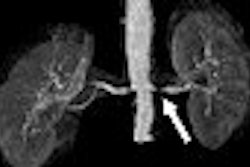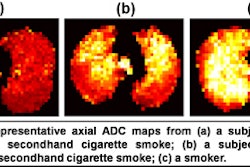Cervical tumor volume may be an insufficient marker for changes during fractionated radiotherapy, according to a study in the January issue of the International Journal of Radiation Oncology, Biology, Physics. Instead, researchers from Toronto have developed a multivariate strategy to better predict tumor response during treatment.
One of the main components of their strategy is serial MRI, which "during radiotherapy has demonstrated a rapid reduction in cervical cancer volume in some patients," explained Dr. Karen Lim and colleagues from the Princess Margaret Hospital, the Ontario Cancer Institute, and the University of Toronto (IJROPB, January 2008, Vol. 70:1, pp. 126-133).
The goals of this study were to evaluate tumor regression during external-beam radiotherapy (EBRT) with weekly MRI, correlate cervical cancer regression with pretreatment hypoxia, and estimate important biologic determinants of radiation response by related MRI measurements to the biologic model.
Twenty seven women were enrolled (14 with squamous cell carcinoma, 13 with adenocarcinoma). The majority (17 patients) was stage IIB or stage IIIB based on the International Federation of Gynecology and Obstetrics (FIGO) criteria.
All patients underwent EBRT, concurrent cisplatin chemotherapy, and brachytherapy. Pelvic EBRT was delivered with a four-field technique and 18-MV photons to a dose of 45-50 Gy in fractions of 1.8-2 Gy. Treatment was given as one fraction a day, five days a week.
MRI was done on a 1.5-tesla scanner (Excite, GE Healthcare, Chalfont St. Giles, U.K.) with a torso coil over the pelvis, and the protocol included axial T2-weighted, fast spin-echo images acquired from the sacral promontory to the bottom of the obturator foramen.
The authors developed a radiobiologic model to describe tumor regression during fractionated EBRT and to estimate regression parameters based on patient data. The model consisted of six independent variables:
- Total Gy dose
- Overall treatment time in days
- In vivo surviving proportion of cells after 2 Gy (SP2)
- Cell clearance constant in days (Tc)
- Cellular proliferation constant in days (Tp)
- Time to the start of accelerated repopulation in days (Tk)
The model was then matched to serial MRI measurements of tumor volume during EBRT to yield estimates of SP2 and Tc for each tumor. Also, regression rates of each patient were calculated from one scan to the next and averaged for the first and last two weeks of treatment.
According to Lim's group, the "results have demonstrated marked patient-to-patient variability in cervical cancer regression during treatment, and the radiobiologic model (allowed) interpretation of that variability in terms of fundamental biologic processes relating to radiation sensitivity (SP2), clearance of irreparably damaged cells from the tumor (Tc), and accelerated repopulation (Tp and Tk) of the surviving cells."
The median pretreatment tumor volume was 33 cm3. The authors found that the tumors regressed slowly during early treatment, which implied more complex response dynamics. The median tumor volume at the end of EBRT was 6.9 cm3.
Based on the biologic model simulation, SP2 and Tc influenced the shape of the volume response curve during EBRT and the relative tumor volume at the end of treatment, with low SP2 values (< 0.4) tied to exponential disease regression.
In contrast, tumors with high SP2 values were predicted to regress slowly early in treatment and more quickly at the end of treatment. Overall, a low SP2 and short Tc were associated with the greatest disease regression during EBRT. Finally, for radiosensitive tumors with low SP2 values, radiation cell killing was found to overwhelm repopulation.
The authors also found a "good fit" between the model data and the actual patient results. They classified patients as having radioresistant or radiosensitive tumors by dividing them into two groups based on median SP2 value (0.71).
"Radioresistant tumors with an SP2 > 0.71 were significantly more hypoxic than were radiosensitive tumors," they wrote. "The median SP2 for the 27 cervical carcinomas in this series was 0.71, and the median Tc was 10 days."
"The biologic relevance of the cell clearance constant Tc in our model reflects multiple interrelated biologic processes that influence cell metabolism, proliferation, and death," they added.
Whether these factors are affiliated with long-term outcomes and disease-free survival still needs to be studied, the authors stated. However, based on these biologic processes that determine regression, they are currently experimenting with adaptive pelvic intensity-modulated EBRT during which treatment plans are revised multiple times during the course of therapy. This real-time treatment modification could enhance optimal target coverage while minimizing toxicity.
By Shalmali Pal
AuntMinnie.com staff writer
January 30, 2008
Related Reading
PET/CT shows its worth in cervical carcinoma, January 18, 2008
Toxicity levels with gynecologic chemoradiation deemed acceptable, November 28, 2007
Early invasive cervical cancer imaging better with MRI than CT, November 8, 2007
FDG-PET, MRI show worth in tumor treatment response, November 2, 2007
Pilot study shows link between FDG uptake and biomarkers of cervical cancer, September 11, 2007
Copyright © 2008 AuntMinnie.com




















